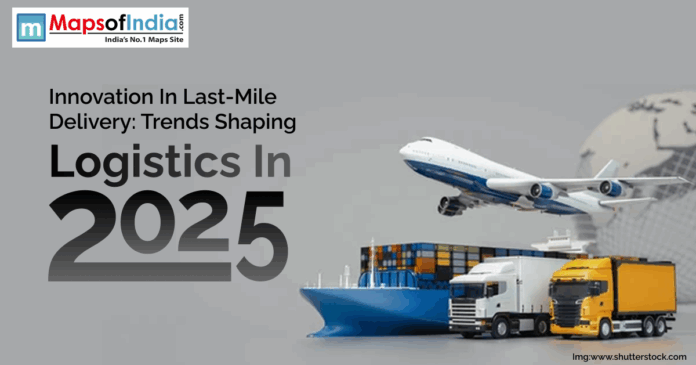The last-mile delivery in the contemporary fast-moving and consumerist economy has become the most important and competitive part of the logistics chain. It may be groceries, clothing or a computer gadget, but the customer now expects their goods to be delivered to their doorstep in a fast, convenient and sometimes at no extra cost. This has caused a high rate of innovation by companies, which is transforming the operations of last-mile delivery. Drones are changing the way goods are delivered to the doorstep of customers, as is AI-based route optimization, among other factors.
Why Last-Mile Delivery Matters
The last part of the supply chain is known as a last-mile delivery, which is the process of delivering goods to the home address of the customer after leaving a transportation centre. It might seem to be a minor component of the total logistics system, but in many cases, it is the most costly and time-consuming one. Research indicates that last-mile delivery may cost up to 53 per cent of the overall shipping expenses, which is a significant business challenge. In addition, this stage is crucial to customer satisfaction. Any lack of transparency, misdelivery or delay can destroy trust immediately.
This is where innovation comes in, and this revolutionizes efficiency, cost-effectiveness, and sustainability in operations in the last-mile.
Drone Delivery: Taking Logistics to the Skies
Drones are one of the greatest innovations in last-mile delivery. Drones are unmanned vehicles that are unmanned and can deliver small to medium-sized packages to customers. Other companies such as Amazon (Prime Air), UPS Flight Forward, and Zipline are already testing and, in other instances, deploying drone deliveries.
The benefits are clear:
- Speed: Drones can avoid road traffic and deliver packages in a few minutes, particularly in urban and congested locations.
- Accessibility: Remote or rural areas that have poor road access can get the necessary supplies within a shorter period.
- Cost Savings: The long-term effect is that the companies will be able to save on the costs of operations as they will no longer need to rely on ground vehicles and drivers. Saying that, Zipline has already managed to roll out drones in Rwanda and Ghana and deliver medical supplies, vaccines, and blood to remote locations and save lives, to create a precedent in the future.
Autonomous Delivery Vehicles
Self-driving delivery robots and autonomous vans are also becoming more popular, along with drones. These are box-like robots, developed by such companies as Starship Technologies and Nuro, that are already supplying food and groceries in some cities. They are equipped with sensors and AI-controlled navigation, hence capable of traveling on the pavement or roads, and making deliveries safely and without contact.
Self-driving vehicles will also be able to carry more packages simultaneously; hence, they would be useful in a metropolis with a high density of deliveries. It is a fight to adopt it on a large scale that countries are struggling to but the current developments can see a bright future.
Route Optimization with Artificial Intelligence
The use of artificial intelligence and machine learning is changing the process of planning and executing delivery routes. Conventionally, motorists were using predetermined routes which did not consider real-time aspects like traffic jams, weather or closures, among other aspects. Today, AI-driven logistics services can process real-time data to offer optimal delivery routes to use less fuel and deliveries are accomplished quickly.
Indicatively, the UPS ORION system (On-Road Integrated Optimization and Navigation) has spared millions of gallons of fuel in a year by optimizing the route of its drivers. In addition to cost reduction, AI-dominated systems enhance the customer experience by offering precise delivery windows and live tracking updates.
Micro-Fulfillment Centers and Dark Stores
The next technology that is changing the last-mile delivery is the introduction of micro-fulfilment centres and dark stores. They are small warehouses but in strategic locations to bring high demand products closer to the consumers. Businesses can supply local centres with orders, be it a local and not a distant central warehouse.
Micro-fulfilment centres (frequently robot-driven) are being invested in by grocery chains such as Walmart and Kroger to accelerate the order picking process. Equally, the e-commerce players are transforming the conventional retail stores into dark stores, which are used solely to take online orders. This model greatly reduces delivery time, and at times can deliver in the same hour.
The Role of Electric Vehicles (EVs) in Sustainable Delivery
Due to the booming e-commerce, sustainability has emerged as an issue of concern. Delivery trucks also generate a lot of carbon, particularly in cities. As a response to this, the utilization of electric vehicles (EVs) by logistics companies in the form of last-mile delivery is gaining momentum.
Other companies, like Amazon, FedEx, or DHL, have invested in the electrification of most of their fleets. EVs do not only contribute to the curb of carbon emission, but they also reduce the costs of operation because they reduce the price of fuel. EVs provide a long-term and environmentally friendly solution to the last-mile logistics combined with the optimization of the routes.
Smart Lockers and Contactless Delivery
Another aspect that innovation is changing is in the area of consumer convenience. Customers are granted flexibility by smart lockers and parcels that are usually located in apartment complexes, shopping outlets, or open spaces. Customers will be able to pick their packages when they want, and the number of unsuccessful deliveries will be reduced, and efficiency will be enhanced.
The significance of contactless delivery grew high during the COVID-19 pandemic. Nowadays, a contactless solution is a standard feature of most companies, whether in the form of lockers, autonomous robots or by ordering a drop to the doorstep with an application.
Challenges and the Road Ahead
There are concerns in spite of the fact that such innovations like drones, autonomous vehicles, and AI have enormous potential. High initial expenses, regulatory permissions, safety issues and infrastructure constraints reduce mass adoption. As an example, the aviation regulations in most countries restrict drone deliveries, restricting their scalability. On the same note, autonomous delivery robots require special lanes or walkways, which are not everywhere.
However, these obstacles will be reduced as technology advances and the demand of the customers increases. It is companies that take these innovations early that will have a competitive advantage by providing faster, cheaper and greener delivery solutions.
Conclusion
The last-mile delivery has ceased to be only about transportation of goods, but it is also about generating value and convenience, as well as trust for the customers. Robotic products such as drone deliveries, AI-enhanced route planning, self-driving vehicles, and sustainability are transforming the industry. Still, the situation is not entirely rosy, yet the future of last-mile delivery is obviously faster, intelligent, and sustainable.
Companies that are fast in adaptation and take advantage of such technologies will not only satisfy the demands of their customers but will also determine the future of the entire world’s business.




